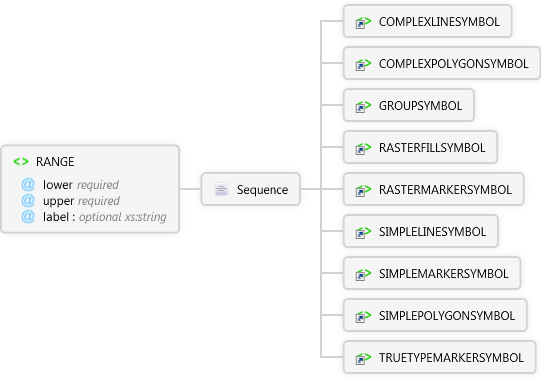 Description
Description
Used with VALUEMAPRENDERER for matching a range of values within a specified field in a shapefile's DBF table. When a match occurs, the symbol is drawn as specified for each range.
 Diagram
Diagram
 Overview
Overview
 |
RANGE
Used with VALUEMAPRENDERER for matching a range of values within a specified field in a shapefile's DBF table. When a match occurs, the symbol is drawn as specified for each range.
 |
lower required
Lower value of range; can be a numeric, string, or date value.
|
 |
upper required
Upper value of range; can be a numeric, string, or date value.
|
 |
label optional xs:string
Label for legend.
|
 |
Sequence
 |
COMPLEXLINESYMBOL
Used to symbolize line features. Provides additional symbology options beyond SIMPLELINESYMBOL.
|
 |
COMPLEXPOLYGONSYMBOL
Used to symbolize polygon features. Provides additional symbology options beyond SIMPLEPOLYGONSYMBOL.
|
 |
GROUPSYMBOL
Used to symbolize features with multiple symbols acting as a single symbol (e.g., a freeway line symbol consists of a group of 3 line symbols).
|
 |
RASTERFILLSYMBOL
Symbolizes polygon features using the specified image as a fill symbol.
|
 |
SIMPLEMARKERSYMBOL
Used to symbolize point features using one of the predefined symbol types: circle, square, cross, triangle, star, X, or diamond.
|
|
|
 Attributes
Attributes
| Name | Type | Use | Default | Fixed | Description |
|---|
| lower | | required | | | Lower value of range; can be a numeric, string, or date value. |
| upper | | required | | | Upper value of range; can be a numeric, string, or date value. |
| label | xs:string | optional | | | Label for legend. |
 Examples
Examples
| ArcPad layer file (*.apl) |
 Copy Code Copy Code |
<?xml version="1.0" encoding="UTF-8" ?>
<ArcPad>
<LAYER name="Damage">
<SYMBOLOGY>
<VALUEMAPRENDERER lookupfield="damage">
<RANGE lower="0" upper="20" label="0 - 20 percent">
<TRUETYPEMARKERSYMBOL character="51" font="ESRI ArcPad" fontstyle="regular" fontsize="8" angle="360" fontcolor="255,0,0"/>
</RANGE>
<RANGE lower="21" upper="40" label="21 - 40 percent">
<TRUETYPEMARKERSYMBOL character="51" font="ESRI ArcPad" fontstyle="regular" fontsize="11" angle="360" fontcolor="255,0,0"/>
</RANGE>
<RANGE lower="41" upper="60" label="41 - 60 percent">
<TRUETYPEMARKERSYMBOL character="51" font="ESRI ArcPad" fontstyle="regular" fontsize="14" angle="360" fontcolor="255,0,0"/>
</RANGE>
<RANGE lower="61" upper="80" label="61 - 80 percent">
<TRUETYPEMARKERSYMBOL character="51" font="ESRI ArcPad" fontstyle="regular" fontsize="17" angle="360" fontcolor="255,0,0"/>
</RANGE>
<RANGE lower="81" upper="100" label="80 - 100 percent">
<TRUETYPEMARKERSYMBOL character="51" font="ESRI ArcPad" fontstyle="regular" fontsize="20" angle="360" fontcolor="255,0,0"/>
</RANGE>
<OTHER label="No Data">
<TRUETYPEMARKERSYMBOL character="64" font="ESRI ArcPad" fontstyle="regular" fontsize="16" angle="360" fontcolor="0,0,0"/>
</OTHER>
</VALUEMAPRENDERER>
</SYMBOLOGY>
</LAYER>
</ArcPad>
|
 Restrictions
Restrictions
- One renderer child element is required for each RANGE element in the value map.
 Source
Source
<xs:element name="RANGE" xmlns:xs="http://www.w3.org/2001/XMLSchema">
<xs:annotation>
<xs:documentation>Used with VALUEMAPRENDERER for matching a range of values within a specified field in a shapefile's DBF table. When a match occurs, the symbol is drawn as specified for each range.</xs:documentation>
</xs:annotation>
<xs:complexType>
<xs:sequence>
<xs:element ref="apl:COMPLEXLINESYMBOL" />
<xs:element ref="apl:COMPLEXPOLYGONSYMBOL" />
<xs:element ref="apl:GROUPSYMBOL" />
<xs:element ref="apl:RASTERFILLSYMBOL" />
<xs:element ref="apl:RASTERMARKERSYMBOL" />
<xs:element ref="apl:SIMPLELINESYMBOL" />
<xs:element ref="apl:SIMPLEMARKERSYMBOL" />
<xs:element ref="apl:SIMPLEPOLYGONSYMBOL" />
<xs:element ref="apl:TRUETYPEMARKERSYMBOL" />
</xs:sequence>
<xs:attribute name="lower" use="required">
<xs:annotation>
<xs:documentation>Lower value of range; can be a numeric, string, or date value.</xs:documentation>
</xs:annotation>
</xs:attribute>
<xs:attribute name="upper" use="required">
<xs:annotation>
<xs:documentation>Upper value of range; can be a numeric, string, or date value.</xs:documentation>
</xs:annotation>
</xs:attribute>
<xs:attribute name="label" type="xs:string">
<xs:annotation>
<xs:documentation>Label for legend.</xs:documentation>
</xs:annotation>
</xs:attribute>
</xs:complexType>
</xs:element> |
 See Also
See Also


 Copy Code
Copy Code






